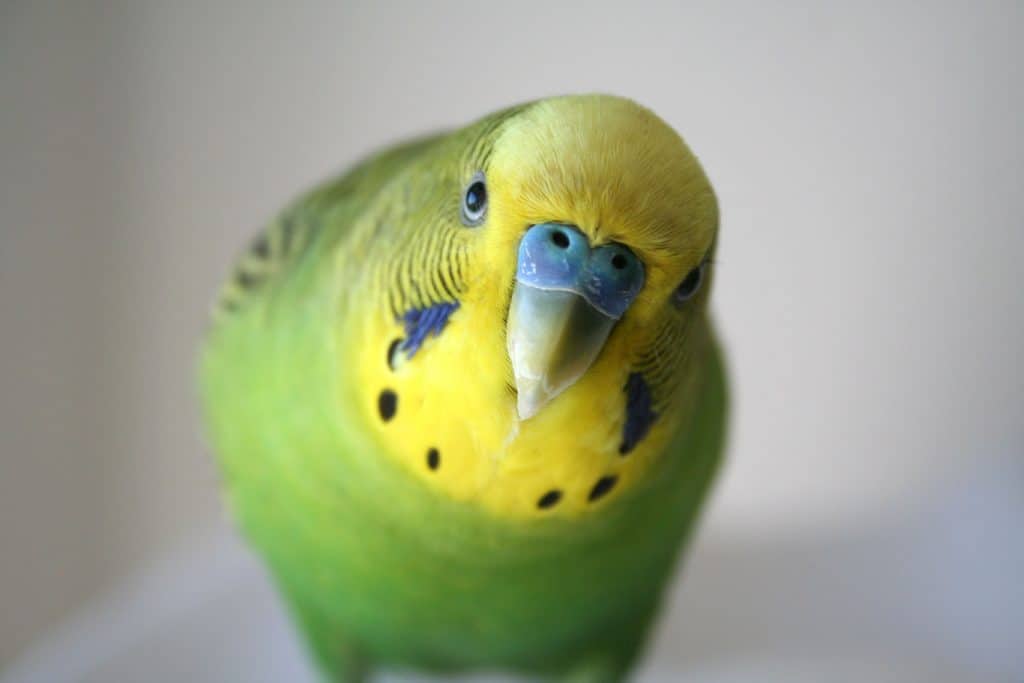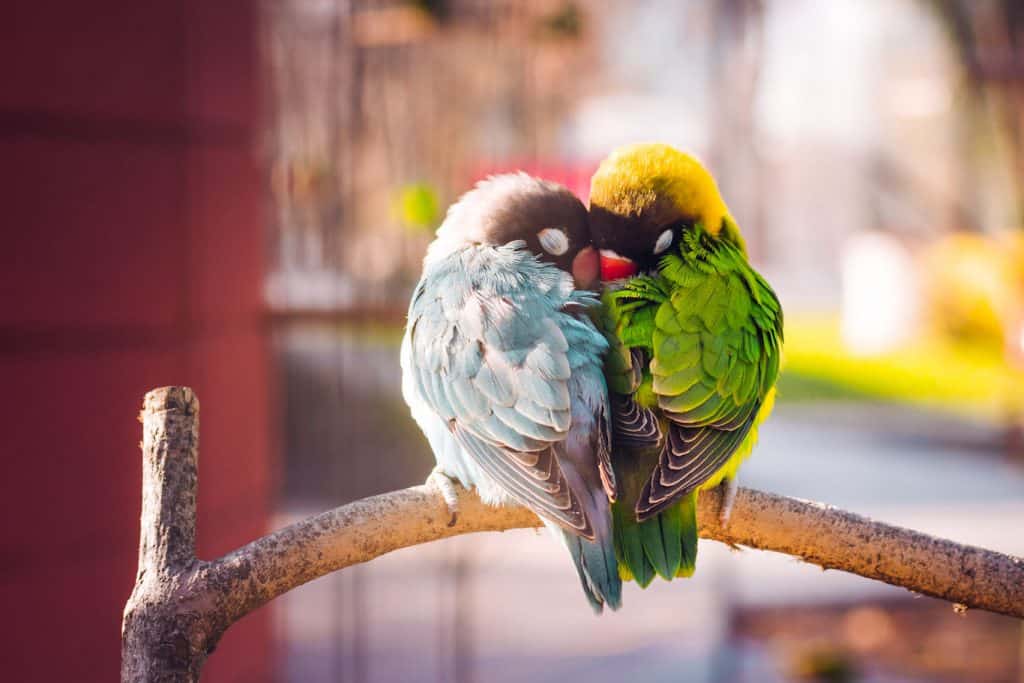Are you curious to know the difference between parakeets and lovebirds? Although both birds descend from parrots, they still have a lot of differences, both physical and behavioral, and both are stunning on their own.
Lovebirds and parakeets are different in almost every way, including size, appearance, coloration, behavior, noise level, ability to get trained, aggressiveness toward other pets, and even the cost of getting them and caring for them are different.
Parrots, especially those two birds, are common and popular pets worldwide. However, knowing the difference between them can help you determine which one suits you better.
Let’s start!
How To Tell The Difference Between Parakeets And Lovebirds?
Each breed of bird is unique and can relate to you as a pet owner in different ways. They are small and lovable pets, perfect for human companionship.
In general, lovebirds are initially from Madagascar and Africa. They are curious little characters who bond intensely with their mate.
You could say that a parakeet is a smaller parrot with a long tail and that many species exist. The most popular is the budgerigar or “budgie,” which originates from Australia and Tasmania. Another popular parakeet species is the Bourke, which is originally from Australia.
But, here are the main differences between lovebirds and parakeets:
1. Lovebirds And Parakeets Differences In Appearance
Lovebirds are small birds that go between 5 and 6.5 inches, although they are bigger than many parrots. They have short tail feathers (while parakeets have longer tails). So in lovebirds, the tail looks blunted while you can see it pointed in parakeets.
Lovebirds
LoveBirds look stockier than parakeets, and since there are different species of lovebirds, they come with several colors in their face and their plumage. For example, they can have the following colors:
- Rosed-peached face and dark green-black plumage (Agapornis roseicollis)
- Black face with a yellow collar (Agapornis Personata)
- Orange-brown face with green-blue plumage (Agapornis fischeri)
- Dark-brown face with dark green plumage (Agapornis Nigrigenis)
- Green face with black wings (Agapornis Taranta)
- Gray-headed and dark green wings (Agapornis Cana)
- Red-faced and green plumage (Agapornis Pullaria)
- Black-collared and green plumage
Parakeets

Parakeets include many species, but they all share similar body characteristics. They have a slim, colorful body, long tail, x-shaped feet ( with two toes pointing backward and forward).
Parakeets have many colors that can go from green to yellow, violet, orange, blue, and more. Therefore, it is possible to find green and yellow birds with black marks and black or dark green birds in the wild.
Parakeets kept in captivity are easier to develop another series of colors, such as yellow, white, violet, gray, green, blue, and cobalt. Usually, one bird has several colors on the body and plumage.
2. Lovebirds And Parakeets Differences In Behavior
Both birds are very friendly, adorable pets for humans and have distinctive characteristics.
Here are the most critical behavioral characteristics:
Lovebirds

Lovebirds are named explicitly because of their strong ability to bond with other birds of the same species and affectionate behavior. For example, they used to awaken at dawn, begin to chirp and become quieter during mid-morning.
In the afternoon, they resume their vocal activities. But chirping is not their main activity. Instead, lovebirds are curious birds. They love to have toys to play with, explore, and move around.
If they are not in their cage, they love to go around and discover new territories. If they are in a cage, it is necessary to provide bells, ladders, mirrors, and shiny objects to keep them happy. You can expect a lovebird to be a social pet, and usually, you should pair them with another bird.
Toward their mate, they are very loyal while being aggressive toward other types of birds. But when lovebirds bond, they are sweet toward each other. You can observe them grooming, feeding each other, and staying close with their mate of bird friends.
Parakeets
Parakeets are not fond of mating but are still affectionate and social animals. As a result, those birds can become affectionate and attached to their humans.
They show affection, chirping, and singing to their humans and would easily sit on the shoulder, kissing their owners lightly. When parakeets do not have a mate, they tend to be attached to toys or various objects.
Although they are not so obsessed with mating, if they become too attached to an object, it is a sign they need a companion.
For example, parakeets can become attached to their human or become obsessed with a mirror since they see another bird.
In general, you can see a parakeet’s state of happiness by how they are busy singing and talking. Often they also flap their wing if they are excited. Parakeets like to chew objects to keep their beaks in good condition, and their owners should always provide safe objects for them to chew on and enjoy.
3. Lovebirds And Parakeets Differences In The Level Of Noises
If you are not tolerant of noises, you should consider a quieter bird. Although all birds will chirp and sing, some used to do it less than others. Between parakeets and lovebirds, the first one is the least loud.
Most of the time, parakeets communicate with a gentle and soft sound, besides if they are afraid or stressed when you will hear a sort of screech. In this case, the sound is not that pleasant. Lovebirds, on the other side, are louder.
Since they are more social, birds will communicate more to attract your attention. They compensate for their loud behavior with a lot of affection. Still, people who live near intolerant neighbors or have problems with loud sounds should go for parakeets.
Parakeets can also be loud and make noises throughout the day, but there are ways to train them to be quieter and vocalize less. Lovebirds, instead, are known to be loud and vocalize to their owners often.
The bird’s volume helps to display their curiosity about what is happening around them. You can expect lovebirds to be more active in the morning and the evening. At the same time, parakeets are more involved in the late morning.
4. Lovebirds And Parakeets Differences In The Amount Of Care
Maintaining both birds requires everyday maintenance actions, which can take between 1 to two hours maximum a day, depending on how much bird owners want to spend in playtime. Here are the typical actions required to take care of both parakeets and lovebirds:
- Feeding
- Provide fresh water
- Cleaning of the cage
- Playtime/training
The time you spend taking care of lovebirds or parakeets can increase if you train them to do tricks. Parakeets require regular training sessions for them to retain what they have learned.
Young birds are better to train, and each training session can get better results than training sessions done with adult birds. In addition, lovebirds can learn faster and retain better what they know.
If you have two birds, it is possible to get away with the playtime because they can entertain interacting with each other, and you can spend less time with them.
5. Lovebirds And Parakeets Differences In Life Span
Parakeets count many species, and each one has a different estimated lifespan. However, you can generally expect a parakeet to live between 5 to 30 years across the various species.
For example, you can expect a monk parakeet to live between 25-30 years, a Budgerigar between 5-8 years, and a plain parakeet to live between 18-20 years.
Lovebirds have a lifespan between 15 to 30 years. It varies, depending on the species and if they are in captivity or live in the wild. Birds owners can extend the life of their pets by adopting proper measures.
For example, providing high-quality food, clean and fresh water every day, providing good entertainment and enrichment can extend the life of their loving parakeets or lovebirds. But, conversely, stress can affect the life span of those birds more than any other thing.
The environment should be safe and free from scary factors, such as noises, sudden movements, or other pets that can scare them. In addition, lovebirds and parakeets should do daily exercise or a bit of flying to keep in shape and avoid becoming fat.
15% of parakeet deaths have been linked to an increase in weight, and so one of the main reasons for a decreased lifespan.
6. Lovebirds And Parakeets Differences In Aggression
Providing that parakeets and lovebirds are both loving and affectionate birds, there are some moments when they can show aggressive behavior. For example, lovebirds can show aggression towards other pets and other breeds of birds.
While they are very friendly with other lovebirds and their owners, you should keep lovebirds separated from smaller and more fragile birds.
The reason is that lovebirds are dangerous to smaller birds because of their potentially aggressive behavior. Parakeets, instead, are friendlier even with other breeds of birds.
7. Lovebirds And Parakeets Differences In Costs
Birds are generally less expensive in maintenance and initial costs than larger pets such as dogs or cats. For example, to get a parakeet, one spends between $12 to $70.
A lovebird, instead, can cost between $25 to $1500, depending on the species. Whether or not you are getting it from a breeder can also affect the price.
To the initial costs, one has to add the cost of the cage, the vet, and daily food, which are similar for both birds. In addition, both parakeets and lovebirds also need toys and other items to live a happy life.
One can expect to spend around $200 every year to maintain a lovebird or a parakeet in addition to the initial costs of purchase and initial equipment. This amount doesn’t include additional trips to the vet.
In summary, you should consider having to spend at least $300 for a parakeet to buy the bird, cage, and food for the first year. However, you could pay the same amount for lovebirds if you are not purchasing a more expensive breed.
The vet bills can add to those numbers, including routine vaccination, emergencies, parasites treatments, and general checkups. So you could expect to spend anything between $100 to $ 2000 in a year.
Hopefully, there are no emergencies, and you need to cover only routine vaccinations and parasite treatment. These essential veterinary treatments can amount to around $100 in a year.
Frequently Asked Questions
What Is The Difference Between Parrots And Lovebirds?
Lovebirds are different than parrots because they are larger and weigh more. In addition, the male and the female parrot look different from each other, while in lovebird, it isn’t easy to see the difference.
In fact, male parrots are more colored than females, so humans can spot them quickly as they tend to stand out. In addition, parrots are less noisy and more easily trained to learn words than lovebirds.
Are Lovebirds Noisy?
Lovebirds are noisy. They are considered pretty vocal and chattery birds. They like to socialize, attract attention, and are curious about their environment. They want to explore fly around, and when they do not have a lot of entertainment, they can vocalize a lot.
The part of the day in which they are noisier is the early morning. Fortunately, they used to sleep at night.
Are Lovebirds Cuddly?
Lovebirds are known to be cuddly birds. It is possible to observe them often snuggle with their mate, cuddle, and sleep closely. But, of course, they also love to snuggle with their humans.
They adapt and like to be handled by people, and it is possible to observe them climbing on someone’s shoulder and snuggling near someone’s head or under the chin.
How Smart Is A Lovebird?
Lovebirds are brilliant pets. They are visibly curious and like to explore, keeping their mind open and stimulated. They are also easy to train, which confirms their intelligence.
Their inquisitive nature further demonstrates their smartness, which keeps them actively engaged, preventing them from getting bored.
These Articles May Also Interest You
- Can Parakeets Eat Grapes?
- Parakeets and Cockatiels: A Comparison
- Can Parakeets Eat Tomatoes? (Read This First!)
- 5 Reasons Why Parakeets Will Die
- Why Do Parakeets Bob Their Heads?
- When Parakeets Kiss: Why They Do It And What It Means
- Can Parrotlets And Parakeets Get Along? (Find Out Here)
- Can Parakeets Eat Carrots?
- 7 Things A Parakeet Needs
- Parakeets and Cockatiels: A Comparison
- What Does it Mean When Parakeets Puff Up?





